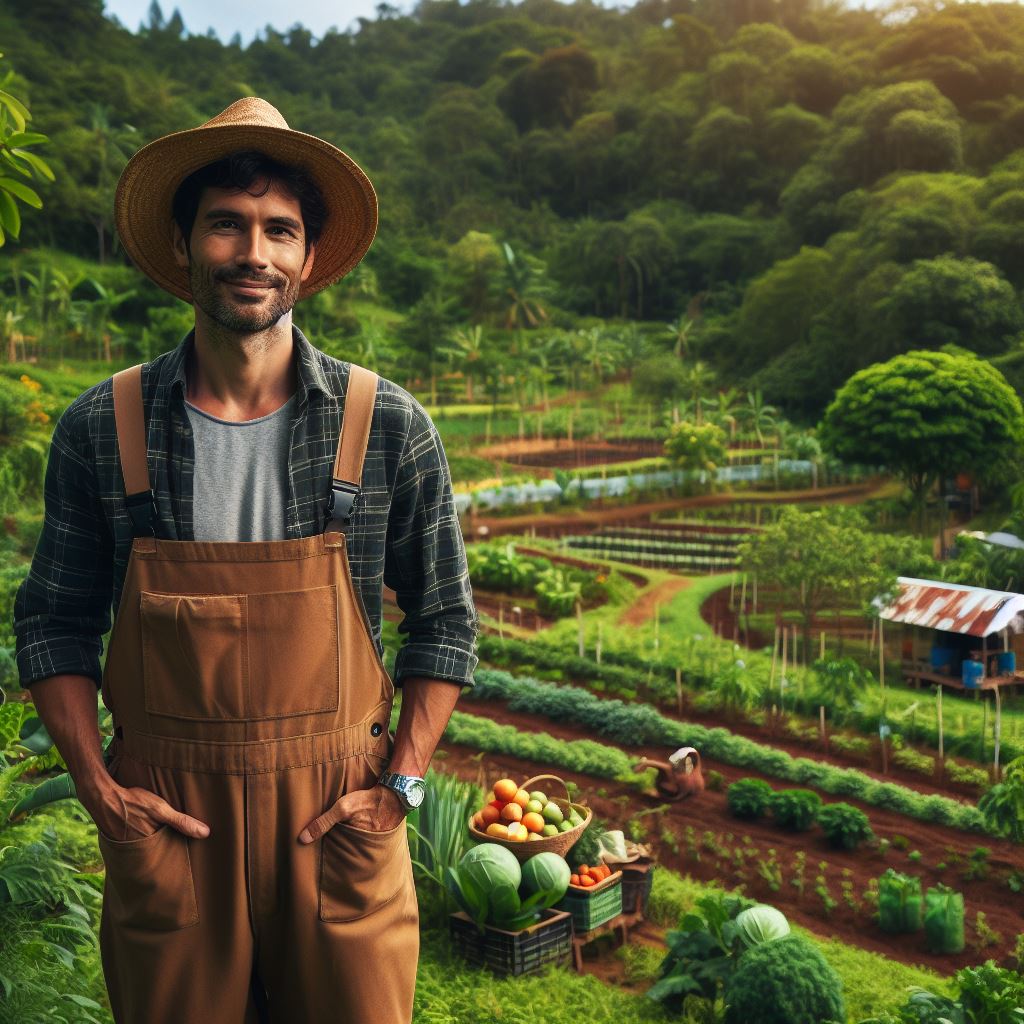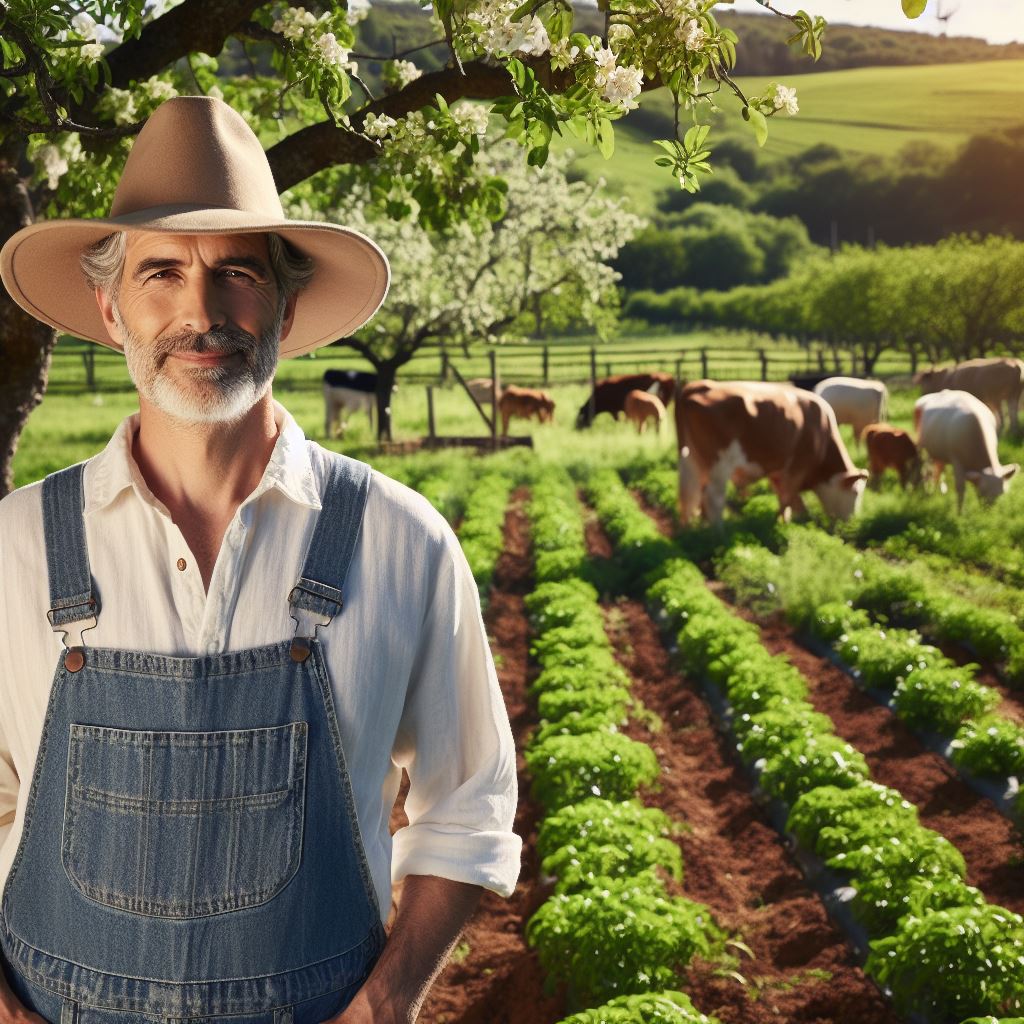Introduction
Sustainable farming plays a vital role in ensuring the long-term viability of our planet’s food production.
It involves implementing practices that minimize the negative environmental impact associated with agriculture.
One crucial aspect of sustainable farming is the relationship between trees and crops.
The connection between trees and crops in sustainable farming is multifaceted. Trees provide numerous ecological benefits for crop production.
They act as windbreaks, reducing soil erosion and protecting crops from strong winds.
The shade provided by trees helps mitigate temperature extremes, creating a more favorable microclimate for crop growth.
Additionally, trees play a crucial role in enhancing soil fertility. Their roots penetrate deep into the ground, breaking up compacted soil and improving drainage.
This allows crops to access water and nutrients more efficiently. Tree leaves also contribute organic matter to the soil when they decompose, enriching its nutrient content.
Furthermore, trees promote biodiversity on farms.
They provide habitats and food sources for beneficial insects and birds, which help control pests that can damage crops.
This natural pest control reduces the need for synthetic pesticides, contributing to a more sustainable farming system.
In short, the synergy between trees and crops is essential for sustainable farming practices.
By strategically integrating trees into agricultural landscapes, farmers can enhance crop productivity, conserve soil health, and contribute to a more sustainable and resilient food system.
Embracing this perfect pair of trees and crops is a crucial step towards a more sustainable future for agriculture.
Benefits of Trees in Sustainable Farms
In sustainable farms, trees offer numerous benefits that contribute to the overall health and productivity of the ecosystem.
Transform Your Agribusiness
Unlock your farm's potential with expert advice tailored to your needs. Get actionable steps that drive real results.
Get StartedA. Improving soil quality
- Trees help enhance soil fertility by providing organic matter through fallen leaves and branches.
- Their deep roots help to stabilize the soil and reduce compaction, allowing better water infiltration.
- The shade provided by trees helps to maintain moisture levels in the soil, preventing evaporation.
- Trees also contribute to nutrient cycling by absorbing minerals from deep within the soil and cycling them back.
B. Enhancing biodiversity
- Trees act as habitats for a wide range of organisms, promoting biodiversity in the farm ecosystem.
- They provide shelter, food, and nesting sites for various birds, insects, and small mammals.
- The diverse vegetation in and around trees supports beneficial insects, which help control pests naturally.
C. Reducing soil erosion
- The roots of trees bind the soil particles together, preventing erosion caused by water and wind.
- The canopy of trees intercepts rainfall, reducing the impact of droplets on the soil surface.
- This, in turn, reduces surface runoff and helps retain moisture in the soil, reducing erosion risks.
D. Providing natural shade and windbreak
- Trees offer natural shade, which helps to lower temperatures and mitigate heat stress in livestock and crops.
- They also act as windbreaks, reducing the impact of strong winds on crops and preventing wind erosion.
- The shade provided by trees can improve livestock comfort and reduce the risk of heat-related illnesses.
- Windbreaks created by trees help to protect delicate crops from wind damage, preserving their quality and yield.
In fact, trees are invaluable assets in sustainable farms. They provide a myriad of benefits, including improved soil quality, enhanced biodiversity, reduced soil erosion, and natural shade and windbreaks.
Incorporating trees into farming practices not only fosters environmental sustainability but also contributes to the long-term viability and productivity of the farm.
Read: Future Farms: How Agroforestry Shapes Tomorrow
Trees as Nutrient Providers for Crops
A. Nitrogen-fixing trees
Nitrogen-fixing trees play a crucial role in sustainable farming by providing a natural and cost-effective way to enhance soil fertility.
These remarkable trees have the ability to convert atmospheric nitrogen into a usable form for plants.
This process, called nitrogen fixation, is vital for the growth and development of crops.
With their mutualistic relationship with nitrogen-fixing bacteria, these trees have the power to convert inert nitrogen gas into ammonia, which can then be converted into nitrate and other forms that crops can readily absorb.
This natural form of fertilization eliminates the need for chemical inputs, reducing costs and environmental contamination.
The benefits of nitrogen-fixing trees extend beyond the direct supply of nitrogen.
They create a healthier and more resilient ecosystem, promoting increased biodiversity and reducing the risk of pests and diseases.
By fostering a balanced and sustainable agroecosystem, they contribute to the long-term viability of farms.
B. Nutrient cycling through tree leaves and root systems
In addition to fixing nitrogen, trees also play a crucial role in nutrient cycling.
Their leaves and roots act as valuable sources of organic matter that break down over time, providing essential nutrients to the soil.
This natural decomposition process enriches the soil with vital elements, enhancing its fertility and overall health.
As tree leaves fall and decompose, they release nutrients such as nitrogen, phosphorus, and potassium, which are crucial for plant growth.
These nutrients are then recycled and made available to nearby crops, ensuring a continuous supply of essential elements.
The deep roots of trees further intensify this nutrient cycling process by accessing nutrients from deeper soil layers and bringing them closer to the surface.
The integration of trees within agricultural systems enhances nutrient cycling and helps maintain a balanced nutrient cycle.
By utilizing the natural resources provided by trees, farmers can significantly reduce their dependence on chemical fertilizers, thereby lowering costs and minimizing environmental impacts.
C. Improving overall crop health and yield
By acting as nutrient providers, trees contribute to improved overall crop health and yield.
The increased supply of essential elements allows crops to reach their full potential, resulting in higher yields and better-quality produce.
Additionally, trees contribute to improved soil structure, moisture retention, and erosion prevention, all of which positively impact crop growth.
The presence of trees in agricultural landscapes also enhances pollination and beneficial insect populations.
Bees and other pollinators are attracted to the flowering trees, increasing pollination rates and subsequently improving fruit and seed set in crops.
Showcase Your Farming Business
Publish your professional farming services profile on our blog for a one-time fee of $200 and reach a dedicated audience of farmers and agribusiness owners.
Publish Your ProfileFurthermore, the presence of beneficial insects, such as predatory wasps and ladybugs, helps control pests naturally, reducing the need for harmful pesticides.
Overall, the integration of trees into farming systems has substantial benefits for sustainable agriculture.
They not only provide essential nutrients to crops but also enhance soil fertility, support biodiversity, and contribute to overall farm resilience.
Harnessing the power of trees is a win-win solution for farmers, as it not only promotes sustainable practices but also leads to higher yields and better profits.
By embracing this perfect pairing of trees and crops, we can pave the way for a more sustainable and prosperous agricultural future.
Read: Agroforestry: A Path to Eco-Friendly Farming
Boosting Farm Resilience with Trees
A. Thwarting pest infestation
One of the significant benefits of incorporating trees into farming practices is their ability to deter pests naturally.
Trees release chemical compounds that repel insects, reducing the need for harmful pesticides.
By planting specific tree species, farmers can create a natural barrier against pests, safeguarding their crop yield.
B. Balancing microclimate
Trees play a crucial role in creating a balanced microclimate on the farm.
They provide shade, reducing temperature fluctuations that can stress crops.
The shade also helps in conserving soil moisture, preventing the rapid evaporation that can lead to drought conditions.
Moreover, trees act as windbreaks, reducing the effects of strong gusts that can damage delicate plants.
C. Shielding crops from extreme weather conditions
Extreme weather events, such as heavy rainfall and strong winds, can pose a significant risk to agricultural productivity.
Trees act as a shield, protecting crops from the adverse impacts of these conditions.
Their extensive root systems help prevent soil erosion, ensuring that nutrients are retained for the crops.
In addition, trees can absorb excess moisture, preventing waterlogging that can harm crop root systems.
By providing a solid barrier against wind, trees also shield crops from being damaged or uprooted during storms.
Their dense canopies offer protection against hail and heavy rainfall, reducing the risk of physical damage.
Overall, the presence of trees on farms increases resilience to extreme weather, allowing for more consistent crop yields.
In essence, integrating trees into farming systems offers numerous benefits, enhancing the overall sustainability and resilience of farms.
The ability of trees to deter pests naturally reduces the reliance on harmful pesticides.
Trees also contribute to a balanced microclimate by providing shade, conserving soil moisture, and acting as windbreaks.
Furthermore, they shield crops from extreme weather conditions, preventing erosion, waterlogging, and physical damage.
Considering these advantages, farmers should explore the incorporation of trees as a perfect pair for sustainable farms.
Read: Boost Yields: Integrating Forestry with Agriculture

Agroforestry Techniques for Effective Integration
A. Alley cropping
- Involves planting crops in between tree rows to maximize land use and enhance productivity.
- Trees provide shade, reduce erosion, and improve nutrient availability for crops.
- Crops benefit from the nutrient-rich soil under the trees, leading to higher yields.
- Tree roots help break up hardpan soil, allowing better water infiltration and reducing compaction.
- Examples of alley cropping systems include planting soybeans between rows of black walnut trees.
B. Windbreaks
- Planting trees in rows to create a barrier that protects crops from strong winds.
- Windbreaks prevent wind erosion, reduce evaporation, and conserve soil moisture.
- They create a microclimate that mitigates temperature extremes, benefiting crop growth.
- Careful species selection is crucial to ensure compatibility with crop requirements.
- Windbreaks can also serve as habitat for beneficial insects and birds, promoting natural pest control.
C. Silvopasture
- Combines trees, forage crops, and livestock in a mutually beneficial system.
- Trees provide shade for grazing animals, improving their welfare and productivity.
- The presence of trees enhances forage quality, as they recycle nutrients and add organic matter.
- Silvopasture systems increase farm income by diversifying products and expanding market opportunities.
- Suitable species for silvopasture include leguminous trees such as leucaena and gliricidia.
D. Riparian buffers
- Consists of vegetation strips along water bodies to protect water quality and create wildlife corridors.
- Trees and other plants filter pollutants, reducing sedimentation and chemical runoff into waterways.
- Riparian buffers stabilize banks, preventing erosion and reducing flood risks.
- The shade provided by trees helps maintain cooler water temperatures, benefiting aquatic ecosystems.
- Planting tall grasses and shrubs in riparian areas can enhance wildlife habitat and biodiversity.
Advantages for sustainable farming offered by Agroforestry techniques
Agroforestry techniques offer numerous advantages for sustainable farming:
- Biodiversity: Integrated trees and crops diversify ecosystems and support a wider range of plant and animal species.
- Soil conservation: Trees improve soil structure, prevent erosion, and reduce nutrient leaching, ensuring long-term soil fertility.
- Carbon sequestration: Agroforestry systems capture and store carbon dioxide, mitigating climate change.
- Water management: Tree canopies reduce water loss through evaporation, while their roots enhance water infiltration and prevent runoff.
- Economic benefits: By combining tree products with crop and livestock production, farmers can diversify income streams and improve resilience against market fluctuations.
- Climate resilience: Agroforestry systems offer resilience against extreme weather events by providing wind and flood protection.
- Shade and microclimate regulation: Trees provide shade for livestock and crops, moderating temperature extremes and creating optimal growing conditions.
- Pollination and natural pest control: Trees attract pollinators and beneficial insects, reducing the need for chemical pesticides.
In general, agroforestry techniques such as alley cropping, windbreaks, silvopasture, and riparian buffers provide effective strategies for integrating trees and crops in sustainable farming systems.
These techniques enhance biodiversity, conserve soil, sequester carbon, manage water resources, and offer economic and climate resilience.
By incorporating tree-based practices, farmers can create sustainable and productive farms while promoting environmental stewardship.
Read: Sustainable Farming: Agroforestry in Action
Success Stories of Trees and Crops Integration
These case studies illustrate the numerous benefits of integrating trees and crops in agricultural practices.
The synergy between trees and crops contributes to sustainable farming, ensuring long-term environmental and economic viability.
A. Case study 1: The use of agroforestry in organic fruit farms
By utilizing agroforestry techniques, organic fruit farmers in California witnessed remarkable improvements in their farms.
The strategic placement of fruit trees alongside cash crops allowed for mutualistic relationships to thrive.
The trees provided crucial shade, shielding the crops from harsh sunlight and minimizing water evaporation from the soil.
This microclimate promotion boosted crop growth and enhanced overall yield, leading to higher profits for farmers.
Moreover, the presence of trees fostered biodiversity on the farms. Beneficial insects, attracted by the diverse ecosystem, helped control harmful pests naturally.
This reduced the reliance on synthetic pesticides, resulting in healthier crops and decreased environmental pollution.
Inspired by this success story, organic fruit farmers across the region started integrating trees into their farming systems.
Showcase Your Farming Business
Publish your professional farming services profile on our blog for a one-time fee of $200 and reach a dedicated audience of farmers and agribusiness owners.
Publish Your ProfileThis widespread adoption of agroforestry practices not only increased overall crop productivity but also contributed to the restoration of natural habitats and the conservation of biodiversity.
B. Case study 2: Positive outcomes of tree-crop combinations in developing countries
Similarly, in developing countries like India, tree-crop combinations have played a pivotal role in improving livelihoods and food security.
Farmers in rural areas have successfully integrated trees such as neem and moringa with their staple crops, including grains and vegetables.
Apart from the additional income generated from tree products, the trees provided essential resources for the community.
Fuelwood, timber, and medicinal herbs obtained from the trees fulfilled various needs of local households.
This reduced the pressure on natural forests and preserved their valuable ecosystems.
The intercropping system offered several advantages in terms of soil conservation and fertility.
The shade provided by the trees mitigated soil erosion, maintaining the integrity of agricultural land.
During droughts, the trees’ presence helped retain moisture and protected the crops from extreme weather conditions, ensuring stable yields.
Thanks to the successful implementation of tree-crop combinations, farmers in these developing regions experienced improved living standards.
The integration of trees into their agricultural practices led to higher incomes, reduced vulnerability to climate change, and enhanced food self-sufficiency.
In brief, the success stories of trees and crops integration demonstrate the immense potential for sustainable and profitable farming practices.
Agroforestry techniques and tree-crop combinations have proven to be effective in enhancing productivity, conserving natural resources, and uplifting farming communities.
By embracing these practices, we can pave the way towards a greener and more sustainable future for agriculture.
Challenges and Solutions in Implementing Tree-Crop Integration
A. Competition for resources
1. Limited availability of water
It is crucial to carefully manage water usage, ensuring that both trees and crops receive adequate amounts.
2. Soil nutrient depletion
Implementing crop rotation and using organic fertilizers can help replenish soil nutrients and mitigate competition.
3. Sunlight interception
Pruning trees to allow sunlight penetration and spacing crops appropriately can reduce competition for sunlight.
B. Compatibility of tree and crop species
1. Root competition
Selecting tree and crop species with compatible root systems can minimize competition for nutrients and water in the soil.
2. Shade tolerance
Choosing crop species that can tolerate shade created by trees promotes a harmonious coexistence.
3. Allelopathic effects
Being aware of potential allelopathic effects and avoiding combining species that inhibit each other’s growth is essential.
Strategies to overcome challenges and promote successful integration
A. Agroforestry planning
Carefully designing layouts and selecting appropriate tree and crop combinations can maximize benefits and minimize challenges.
B. Efficient use of resources
Implementing water-saving techniques, such as drip irrigation, can ensure proper resource allocation to trees and crops.
C. Integrated pest management
Adopting biological control methods and using pest-resistant crop varieties can reduce the need for chemical interventions.
D. Nutrient cycling
Utilizing tree leaf litter and crop residues as organic mulch can enhance soil fertility and support both trees and crops.
E. Training and education
Providing farmers with knowledge and skills on tree-crop integration techniques can increase their success in implementation.
F. Financial incentives
Offering financial support and incentives to farmers who adopt tree-crop integration practices can encourage widespread adoption.
G. Market opportunities
Creating demand for tree-crop integrated products can provide farmers with additional income and motivation to implement the system.
H. Research and development
Continual research and development efforts can improve understanding and provide innovative solutions for successful integration.
In a nutshell, while implementing tree-crop integration in sustainable farms presents challenges, such as resource competition and species compatibility, there are strategies and solutions available to overcome these obstacles.
By efficiently managing resources, selecting compatible species, and implementing appropriate techniques, farmers can promote successful integration and reap the benefits of a diversified and sustainable agricultural system.
It is essential for governments, researchers, and farmers to work together in promoting and supporting the implementation of tree-crop integration for the future of sustainable farming.
Conclusion
Tree-crop integration offers numerous benefits for sustainable farms, including improved soil quality, increased biodiversity, and enhanced resilience to climate change.
Tree-crop integration revolutionizes sustainable farming. Enhanced biodiversity fosters resilient ecosystems, reducing reliance on pesticides.
Trees act as natural windbreaks, shielding crops and mitigating soil erosion. Root systems bolster soil structure, curbing nutrient runoff.
Efficient space utilization maximizes yield, optimizing land productivity. Carbon sequestration is amplified, combating climate change.
Agroforestry nurtures a balanced microclimate, promoting crop health and resilience. Farmers, embrace the synergy—profit from diverse income streams.
We encourage farmers to seriously consider implementing agroforestry practices on their farms, as it can lead to long-term sustainability, increased productivity, and economic benefits.




